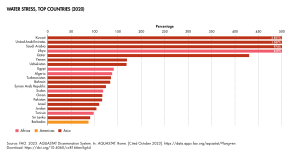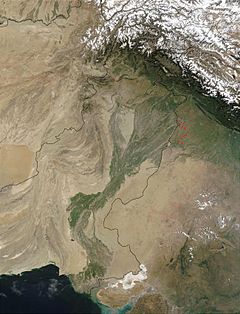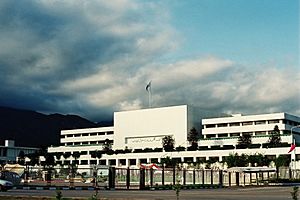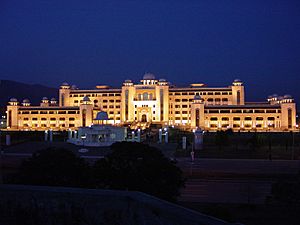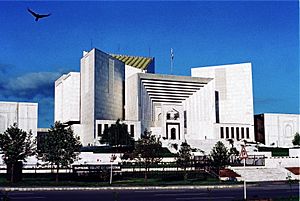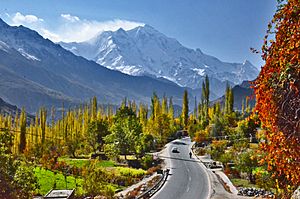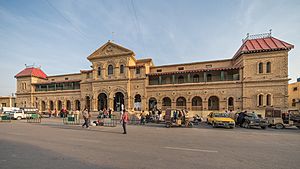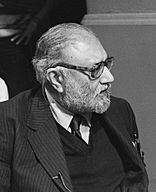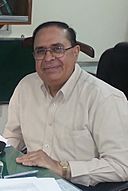Pakistan facts for kids
Quick facts for kids
Islamic Republic of Pakistan
|
|
|---|---|
|
Motto:
|
|
|
Anthem:
|
|

Land controlled by Pakistan shown in dark green; land claimed but not controlled shown in light green (see Kashmir conflict and Annexation of Junagadh)
|
|
| Capital | Islamabad 33°41′30″N 73°3′0″E / 33.69167°N 73.05000°E |
| Largest city | Karachi 24°51′36″N 67°0′36″E / 24.86000°N 67.01000°E |
| Official languages | |
| Native languages | Over 77 languages |
| Religion |
|
| Demonym(s) | Pakistani |
| Government | Federal parliamentary Islamic republic |
| Asif Ali Zardari | |
| Shehbaz Sharif | |
| Yusuf Raza Gilani | |
| Legislature | Parliament |
| Senate | |
| National Assembly | |
| Independence
from the United Kingdom
|
|
| 23 March 1940 | |
| 14 August 1947 | |
|
• Republic
|
23 March 1956 |
|
• Last territory's acquisition
|
8 December 1958 |
| 16 December 1971 | |
| 14 August 1973 | |
| Area | |
|
• Total
|
881,913 km2 (340,509 sq mi) (33rd) |
|
• Water (%)
|
2.86 |
| Population | |
|
• 2023 census
|
|
|
• Density
|
273.8/km2 (709.1/sq mi) (56th) |
| GDP (PPP) | 2024 estimate |
|
• Total
|
|
|
• Per capita
|
|
| GDP (nominal) | 2024 estimate |
|
• Total
|
|
|
• Per capita
|
|
| Gini (2018) | ▼ 29.6 low |
| HDI (2022) | low · 164th |
| Currency | Pakistani rupee (₨) (PKR) |
| Time zone | UTC+05:00 (PKT) |
| DST is not observed. | |
| Date format |
|
| Driving side | left |
| Calling code | +92 |
| ISO 3166 code | PK |
| Internet TLD | |
Pakistan, officially known as the Islamic Republic of Pakistan, is a country located in South Asia. It is home to over 241.5 million people, making it the fifth-most populated country in the world. Pakistan also has the second-largest Muslim population globally.
The capital city of Pakistan is Islamabad, while Karachi is its largest city and a major financial hub. Pakistan is the 33rd-largest country by area, and the second largest in South Asia. It has a coastline along the Arabian Sea and shares land borders with India to the east, Afghanistan to the west, Iran to the southwest, and China to the northeast.
Pakistan has a rich history with ancient cultures. These include the 8,500-year-old Neolithic site of Mehrgarh and the Indus Valley Civilisation from the Bronze Age. Many empires and dynasties have ruled these lands, such as the Mughal Empire and, more recently, the British Raj. Pakistan gained its independence from the United Kingdom in 1947.
Today, Pakistan is considered a middle power nation. It has the sixth-largest armed forces in the world. It is also a nuclear-weapons state. Pakistan is a member of important international groups like the United Nations, the Organisation of Islamic Cooperation, and the Commonwealth of Nations.
Contents
- What Does the Name Pakistan Mean?
- Pakistan's Geography and Climate
- Government and Politics in Pakistan
- Administrative Divisions of Pakistan
- Tourism in Pakistan
- Transport in Pakistan
- Science and Technology in Pakistan
- Education in Pakistan
- People and Languages in Pakistan
- Major Cities in Pakistan
- Religions in Pakistan
- Culture and Society in Pakistan
- Food and Drink in Pakistan
- Sports in Pakistan
- Images for kids
- See also
What Does the Name Pakistan Mean?
The name Pakistan was created by Choudhry Rahmat Ali in January 1933. He was an activist for the Pakistan Movement. He first used the name "Pakstan" in a pamphlet called Now or Never.
Rahmat Ali explained that the name was an acronym. It came from the first letters of different regions: P for Punjab, A for Afghania, K for Kashmir, S for Sindh, and tan from Baluchistan.
He also said that "Pakistan" means "the land of the Paks." In Persian and Pashto, pāk means 'pure'. The Persian ending -stan means 'land' or 'place of'. So, Pakistan means "Land of the Spiritually Pure."
Pakistan's National Symbols
Pakistan has important national symbols that represent its identity. These include its flag and national anthem.
The National Anthem: "Qaumī Tarānah"
Pakistan's national anthem is called "Qaumī Tarānah." It is a beautiful song with three stanzas. The music was composed by Ahmed Ghulamali Chagla in 1949. It blends eastern and western music styles. The anthem usually lasts about 80 seconds.
The words were written by the poet Hafeez Jalandhari in 1952. The lyrics use many words from the Persian language. This makes them understandable to both Urdu and Persian speakers.
The Flag of Pakistan
The flag of Pakistan is mostly green. It has a white crescent moon and a five-pointed star in the middle. There is also a white stripe on the left side. The green color is a special shade called Pakistan green.
The flag was designed by Syed Amir uddin Kedwaii. It was officially adopted on August 11, 1947, just before Pakistan became independent. The white color on the flag represents the country's minorities. The green represents the Muslim majority. The crescent moon stands for progress, and the five-pointed star means light and knowledge.
Pakistan's Geography and Climate
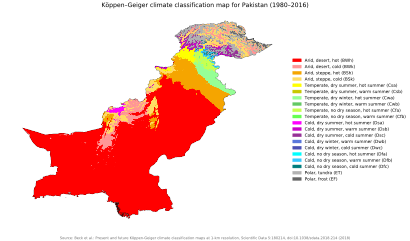
Pakistan has a very diverse geography and climate. This allows for a wide variety of wildlife. The country covers about 881,913 square kilometers. This makes it the 33rd-largest nation in the world.
Pakistan has a 1,046-kilometer coastline along the Arabian Sea and the Gulf of Oman. It shares land borders totaling 6,774 kilometers with its neighbors. These include Afghanistan, China, India, and Iran. Its location is very important because it sits where South Asia, the Middle East, and Central Asia meet.
Geologically, Pakistan is located on two major tectonic plates. The southern parts are on the Indian Plate. Most of Balochistan and Khyber Pakhtunkhwa are on the Eurasian plate. Areas along the edge of the Indian plate are prone to powerful earthquakes.
Pakistan's landscapes range from flat coastal plains to towering glaciated mountains. You can find deserts, forests, hills, and plateaus here. The country is divided into three main geographic areas:
- The northern highlands
- The Indus River plain
- The Balochistan Plateau
The northern highlands include the Karakoram, Hindu Kush, and Pamir ranges. These mountains have some of the world's highest peaks. Five of the fourteen eight-thousanders (mountains over 8,000 meters tall) are here. These include K2 (8,611 meters) and Nanga Parbat (8,126 meters).
The Balochistan Plateau is in the west, and the Thar Desert is in the east. The 1,609-kilometer Indus River flows through the country. Its tributaries create fertile plains in the Punjab and Sindh regions.
Pakistan's climate varies from tropical to temperate. The southern coastal areas are arid (very dry). The country experiences a monsoon season with heavy rainfall and frequent flooding. There is also a dry season with very little rain. Pakistan has four distinct seasons:
- A cool, dry winter (December to February)
- A hot, dry spring (March to May)
- A summer rainy season (June to September)
- A retreating monsoon period (October and November)
Pakistan's Flora and Fauna
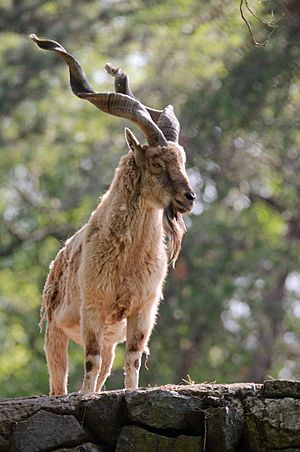
Pakistan's varied landscapes and climates support a wide range of plants and animals. In the northern mountains, you'll find coniferous trees like spruce and pine. In the southern regions, there are palms like coconut and date trees. Mangrove forests grow along the southern coast.
Pakistan is home to about 668 bird species. These include crows, sparrows, hawks, and eagles. Many migratory birds visit from Europe, Central Asia, and India. The southern plains have animals like mongooses, hares, and jungle cats. The Indus River is home to mugger crocodiles.
The mountainous north has animals like the Marco Polo sheep, urial, markhor goat (Pakistan's national animal), and snow leopard. The rare blind Indus river dolphin also lives here. There are about 1,100 of these dolphins left. They are protected at the Indus Dolphin Reserve in Sindh.
Sadly, some wild animals are endangered due to habitat loss and climate change. Pakistan is working to protect its unique wildlife.
Government and Politics in Pakistan
Pakistan is a democratic parliamentary federal republic. This means it has a government where people elect representatives. Islam is the official state religion. In 2010, changes to the constitution gave more power to the prime minister.
- Head of State: The President is the ceremonial head of the state. They are also the civilian commander-in-chief of the Pakistan Armed Forces. The President is chosen by an Electoral College.
- Legislative Branch: Pakistan has a bicameral legislature, meaning it has two houses.
- The Senate is the upper house with 104 members.
- The National Assembly is the lower house with 342 members.
Members of the National Assembly are elected by citizens. The constitution also sets aside 70 seats for women and religious minorities. Senate members are chosen by provincial lawmakers.
- Executive Branch: The Prime Minister is the chief executive and head of government. They are usually the leader of the main party in the National Assembly. The Prime Minister forms a cabinet and makes important government decisions.
- Provincial Governments: Pakistan has four provinces. Each province has its own Provincial Assembly. This assembly elects a Chief Minister. The Chief Minister leads the provincial government.
- Judicial Branch: The court system in Pakistan has two main parts: the superior and subordinate judiciary. The Chief Justice of Pakistan leads the entire court system. The superior judiciary includes the Supreme Court of Pakistan, the Federal Shariat Court, and five high courts. The Supreme Court is the highest court and protects the constitution.
Administrative Divisions of Pakistan
Pakistan is a federation made up of four provinces and three territories.
| Administrative division | Capital | Population |
|---|---|---|
| Quetta | 12,344,408 | |
| Lahore | 110,126,285 | |
| Karachi | 47,886,051 | |
| Peshawar | 40,525,047 | |
| Gilgit | 1,800,000 | |
| Muzaffarabad | 4,567,982 | |
| Islamabad Capital Territory | Islamabad | 2,851,868 |
The four provinces are Punjab, Khyber Pakhtunkhwa, Sindh, and Balochistan. The three territories are Islamabad Capital Territory, Gilgit-Baltistan, and Azad Kashmir. The government of Pakistan also controls parts of the Kashmir Region. These are organized into Azad Kashmir and Gilgit-Baltistan.
In 2009, Gilgit-Baltistan gained a special "semi-provincial status." This gave it more self-government.
Pakistan also has a local government system. This system has three levels: districts, tehsils, and union councils. Each level has an elected body. There are about 130 districts in total.
Tourism in Pakistan
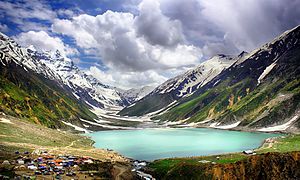
Pakistan is a country with diverse cultures, people, and beautiful landscapes. In 2018, about 6.6 million foreign tourists visited Pakistan. The country was very popular in the 1960s and 1970s. Many travelers on the "Hippie trail" passed through Pakistan on their way to India.
Northern Pakistan is famous for its stunning natural beauty. It has several of the world's highest mountain peaks. Popular places for tourists included the Khyber Pass, Peshawar, Karachi, and Lahore.
Pakistan's tourist spots range from mangrove forests in the south to Himalayan hill stations in the north. You can visit ancient Buddhist ruins like Takht-i-Bahi and Taxila. There are also 5,000-year-old cities from the Indus Valley civilization, such as Mohenjo-daro and Harappa.
The northern part of Pakistan has many old fortresses and examples of ancient architecture. The Hunza and Chitral valleys are home to the small Kalasha community. They claim to be descendants of Alexander the Great.
Lahore, Pakistan's cultural capital, has many examples of Mughal architecture. These include the Badshahi Masjid, the Shalimar Gardens, and the Lahore Fort. In 2006, The Guardian newspaper listed Taxila, Lahore, the Karakoram Highway, Karimabad, and Lake Saiful Muluk as top tourist sites in Pakistan.
The government holds various festivals throughout the year to promote Pakistan's unique culture.
Transport in Pakistan
Pakistan has a well-developed transport system that helps people and goods move across the country.
Motorways: Fast Roads Across Pakistan

Pakistan's motorways are multi-lane, high-speed roads. They are managed by the National Highway Authority. As of February 2020, over 1,882 kilometers of motorways were open. Another 1,854 kilometers were being built or planned. All motorways are named with an 'M' followed by a number, like "M-1."
These motorways are a key part of Pakistan's "National Trade Corridor Project." This project connects Pakistan's three Arabian Sea ports (Karachi Port, Port Bin Qasim, and Gwadar Port) to the rest of the country. It also links Pakistan with Afghanistan, Central Asia, and China. The China Pakistan Economic Corridor project aims to connect Gwadar Port to Kashgar in China using these roads.
Highways: The Backbone of Travel
Highways are the main part of Pakistan's transport system. They cover a total road length of 263,942 kilometers. These roads carry 92% of passengers and 96% of inland freight. The National Highway Authority maintains these important roads.
The highway system mainly connects the southern ports to the populated provinces of Punjab and Khyber-Pakhtunkhwa. Even though this network is only 4.6% of the total road length, it carries 85% of the country's traffic.
Railways: Connecting Cities by Train
The Pakistan Railways operates the country's train system. From 1947 until the 1970s, trains were the main way to travel. However, after national highways were built and more cars became available, people started using roads more.
Today, railways carry less than 8% of passengers and 4% of freight. Pakistan plans to use its rail service to increase trade with China, Iran, and Turkey.
Airports: Flying Across Pakistan
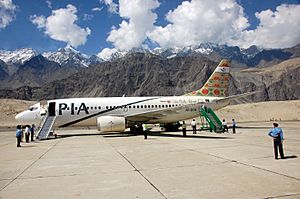
As of 2013, Pakistan had about 151 airports and airfields. These include both military and civilian airports. Jinnah International Airport in Karachi is the main international gateway. Other major international airports are in Lahore, Islamabad, Peshawar, and Quetta.
The aviation industry includes both government-owned and private airlines. Pakistan International Airlines (PIA) is the largest airline. Private airlines like Airblue also offer flights, often at a lower cost.
Seaports: Gateway to the Seas
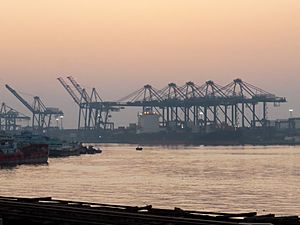
Pakistan's major seaports are in Karachi, Sindh. These include the Port of Karachi and Port Qasim. Since the 1990s, new seaports have been built in Balochistan, such as Gwadar Port. Gwadar Port is one of the deepest sea ports in the world. The quality of Pakistan's port infrastructure has improved over the years.
Science and Technology in Pakistan
Developments in science and technology have greatly helped Pakistan's growth. They have also connected the country to the rest of the world. Each year, scientists from around the globe are invited to the International Nathiagali Summer College on Physics in Pakistan.
Pakistani scientists have made important contributions in many fields. These include mathematics, biology, economics, computer science, and genetics. For example, Abdus Salam, a Pakistani theoretical physicist, won a Nobel Prize in Physics in 1979. He was the first Muslim to win a Nobel prize in science.
In chemistry, Salimuzzaman Siddiqui was the first Pakistani scientist to study the healing properties of the neem tree. Pakistani neurosurgeon Ayub Ommaya invented the Ommaya reservoir. This system helps treat brain tumors.
Abdul Qadeer Khan is known as the founder of Pakistan's atomic bomb project. He established the Kahuta Research Laboratories (KRL) in 1976. He also made important contributions to physics.
In 2010, Pakistan was ranked 43rd in the world for published scientific papers. The Pakistan Academy of Sciences helps guide science policies for the government. In 2023, Pakistan ranked 88th in the Global Innovation Index.
Pakistan witnessed a fourfold increase in its scientific productivity in the past decade surging from approximately 2,000 articles per year in 2006 to more than 9,000 articles in 2015. Making Pakistan's cited article's higher than the BRIC countries put together.
Pakistan also has an active space program led by SUPARCO. In 1962, Pakistan became the first South Asian country to launch a rocket into space. In 1990, it launched its first space satellite. This made Pakistan the first Muslim country and second South Asian country to put a satellite into space.
Pakistan is the first and only Muslim country with an active research presence in Antarctica. Since 1991, it has maintained two summer research stations there.
Internet use has grown rapidly in Pakistan. As of 2020, Pakistan had about 82 million internet users. This makes it one of the top countries for internet growth. The government invests in information technology projects, focusing on e-government and human resources.
Education in Pakistan
The constitution of Pakistan states that the government must provide free primary and secondary education. When Pakistan was formed, it had only one university, Punjab University. Soon after, the government built public universities in each of the four provinces.
Pakistan now has many public and private universities. These universities work together to offer research and higher education. There are also many technical and vocational institutions. Additionally, madrassahs provide free Islamic education, including food and lodging.
Education in Pakistan has six main levels:
- Nursery (preparatory classes)
- Primary (grades one to five)
- Middle (grades six to eight)
- Matriculation (grades nine and ten, leading to a secondary certificate)
- Intermediate (grades eleven and twelve, leading to a higher secondary certificate)
- University programs (leading to graduate and postgraduate degrees)
Many private schools in Pakistan follow a curriculum set by Cambridge International Examinations from the United Kingdom. Some students take the O-level and A level exams.

In 2007, English medium education became mandatory in all schools. In 2012, Malala Yousafzai, a young activist for female education, was shot. She later became the youngest Nobel laureate for her work. In 2013, Sindh province began offering Chinese language courses in schools. This shows China's growing influence in Pakistan.
As of 2018, the literacy rate in Pakistan is 62.3%. The male literacy rate is 72.5%, and the female literacy rate is 51.8%. Literacy rates can vary a lot by region. For example, female literacy in some tribal areas is 9.5%, while in Azad Jammu & Kashmir it is 74%.
The government has launched initiatives to increase literacy and provide basic education to all children. By 2015, the goal was to have 100% enrollment for primary school children. Pakistan spends about 2.3% of its GDP on education. This is one of the lowest rates in South Asia.
People and Languages in Pakistan
Pakistan is a country with many different cultures, languages, and ethnic groups. While Urdu is Pakistan's national language and a symbol of national unity, it is the main language for only about 7% of the population. However, over 75% of Pakistanis understand it.
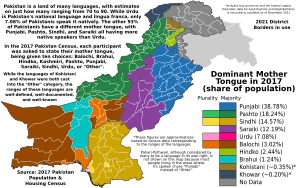
Urdu and English are the official languages of Pakistan. English is mainly used for official business and government. There are between 75 and 85 languages spoken in the country.
According to the 2017 census, the largest ethnic groups are:
- Punjabis (38.8% of the population)
- Pashtuns (18.2%)
- Sindhis (14.6%)
- Saraikis (12.19%)
- Muhajirs (7.08%)
- Balochs (3.02%)
There are also smaller groups like the Brahuis, Hindkowans, and the people of Gilgit-Baltistan. Many Pakistanis also live outside the country. This Pakistani diaspora numbers over seven million people worldwide.
Major Cities in Pakistan
|
Largest cities or towns in Pakistan
According to the 2017 Census |
||
|---|---|---|
| Rank | Name | Pop. |
| 1 | Karachi | 14,916,456 |
| 2 | Lahore | 11,126,285 |
| 3 | Faisalabad | 3,204,726 |
| 4 | Rawalpindi | 2,098,231 |
| 5 | Gujranwala | 2,027,001 |
| 6 | Peshawar | 1,970,042 |
| 7 | Multan | 1,871,843 |
| 8 | Hyderabad | 1,734,309 |
| 9 | Islamabad | 1,009,832 |
| 10 | Quetta | 1,001,205 |
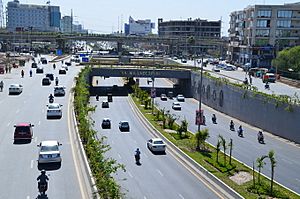
Religions in Pakistan
| Religions in Pakistan (2017 Census) | ||||
|---|---|---|---|---|
| Religions | Percent | |||
| Islam | 96.47% | |||
| Hinduism | 2.14% | |||
| Christianity | 1.27% | |||
| others/non-religious | 0.11% | |||
Islam is the state religion of Pakistan. The constitution guarantees freedom of religion. This means all citizens have the right to practice their religion.
Most Pakistanis (96.47%) are Muslims. There are also significant minorities of Hindus (2.14%) and Christians (1.27%). Smaller groups follow Sikhism, Buddhism, Jainism, and Zoroastrianism. The Kalash people have a unique identity and religion. They practice a form of animism and ancestor worship.
Hinduism is common among Sindhis. Pakistan hosts major Hindu events, like the Hinglaj Yatra pilgrimage. Hindu temples can be found throughout Sindh.
Culture and Society in Pakistan
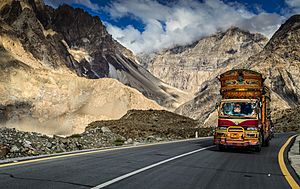
Pakistani society is largely traditional. It emphasizes local cultural etiquette and Islamic values. The basic family unit is the extended family. However, more people are now living in nuclear families.
The traditional dress for both men and women is the Shalwar Kameez. Trousers, jeans, and shirts are also popular. In recent decades, Pakistan's middle class has grown significantly.
Pakistani festivals are mostly religious. These include Eid-ul-Fitr, Eid-ul-Azha, Ramazan, Christmas, Easter, Holi, and Diwali.
Food and Drink in Pakistan
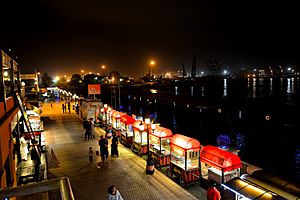
Pakistani food is similar to other cuisines in South Asia. Many dishes come from the royal kitchens of 16th-century Mughal emperors. Pakistani cooking uses many spices, herbs, and seasonings. Garlic, ginger, turmeric, red chili, and garam masala are common.
Roti, a thin flatbread, is a staple food. It is usually served with curry, meat, vegetables, and lentils. Rice is also common. It can be served plain, fried with spices, or in sweet dishes.
Lassi is a traditional drink from the Punjab region. Black tea with milk and sugar is very popular and consumed daily. Sohan halwa is a popular sweet dish from southern Punjab.
Sports in Pakistan
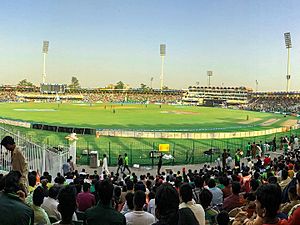
Cricket is the most popular sport in Pakistan. Football has also become very popular recently. Field hockey is the national sport. It was very popular for many decades. Pakistan has achieved great success in both field hockey and squash. Polo and traditional sports like kabaddi are also played.
In cricket, Pakistan has won all major ICC international tournaments. These include the ICC Cricket World Cup, ICC World Twenty20, and ICC Champions Trophy. The Pakistan Super League is one of the largest cricket leagues in the world.
Football in Pakistan has a long history. The Pakistan Football Federation was created shortly after Pakistan's independence in 1947. Pakistan is known for manufacturing the official FIFA World Cup ball.
In field hockey, Pakistan is one of the most successful national teams. It has won a record four Hockey World Cups. It also has eight Asian Games gold medals and three gold medals in the Olympic Games. Pakistan is the only Asian team to have won the prestigious Hockey Champions Trophy.
Squash player Jahangir Khan is considered one of the greatest squash players ever. From 1981 to 1986, Jahangir was unbeaten. He won 555 matches in a row, which is the longest winning streak by any athlete in professional sport.
The annual Shandur Polo Festival in Northern Pakistan attracts international players. It is held at the world's highest polo ground.
Pakistan has hosted many international sporting events. These include the 1989 and 2004 South Asian Games. It also hosted several World Squash Championships and Cricket World Cups. Pakistan is set to host the 2023 South Asian Games, the 2023 Asia Cup, and the 2025 ICC Champions Trophy.
Images for kids
See also
 In Spanish: Pakistán para niños
In Spanish: Pakistán para niños
- Outline of Pakistan
- Administrative divisions of Pakistan




